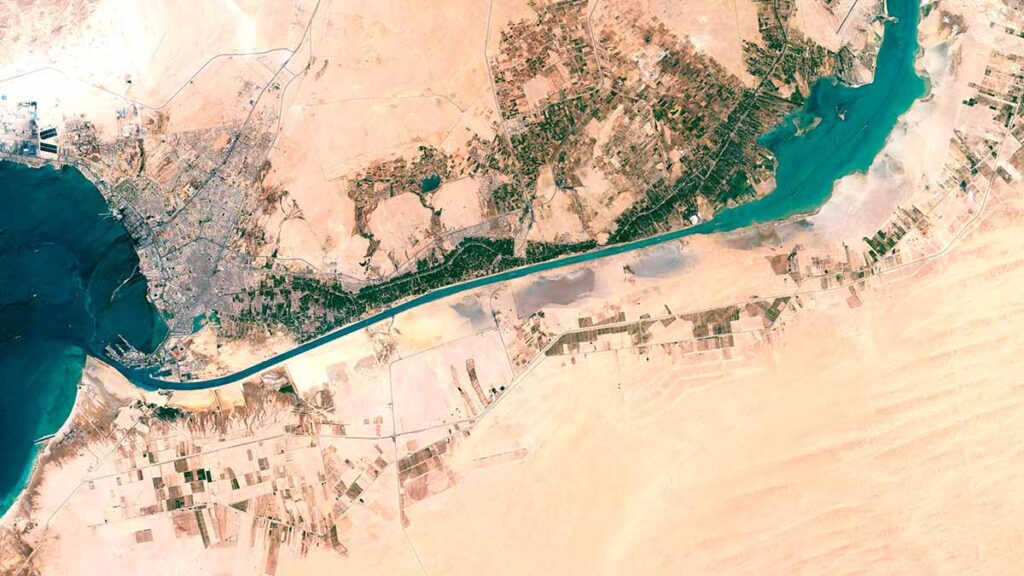Last Tuesday news, on March 23, in which a container ship diagonally blocked the Suez Canal (southern entrance) and was subsequently released after a series of attempts over six days, raised some questions about the possibility of a similar incident occurring in the Panama Canal.
For this reason, we will present some comparative points (or differentiators) between both canals, in order to understand the dynamics of these waterways and the implications of each one in world trade.
Source: CNN/Maxar Techonologies/AP.
Some of the following information comes from a conversation held by Dr. Ricaurte Vásquez Morales, Canal Administrator, with journalists from national media and foreign press correspondents, last Monday, March 29, about the incident in the Suez Canal.
Geographical aspects:
- The Suez Canal is at sea level, so its draft (depth) oscillates with the tides.
- The Panama Canal is made up of a system of locks that raises the ship to the level of Gatun Lake (26 meters above sea level). In addition, the water that feeds our Canal is fresh, because it comes mainly from this lake, and this determines the draft along its channel. Therefore, it is important to have optimal water levels in the Gatun and Alhajuela Lakes, despite the variations in rainfall patterns that influence the draft in the navigational channel. For this reason, the Canal has initiated a prequalification process for the design, evaluation and execution of water projects to ensure the adequate availability of water for human consumption and the operation of the waterway on an ongoing basis.
Extension:
- The Suez Canal has an extension of 193 kilometers, and connects the Mediterranean Sea with the Red Sea.
- The Panama Canal is 80 kilometers long, and connects the Pacific and Atlantic Oceans.
Weather conditions:
- The Suez Canal experiences strong winds and sandstorms that can affect the visibility and maneuvering of ships.
- The main adverse conditions experienced by the Panama Canal are fog and torrential rains. In case either of the two conditions are intense, the pilots, in conjunction with the ground operations personnel, make the decision to reduce the speed of the ships in transit or expect the weather to improve. It should be clarified that these measures are momentary and are taken to ensure the safety of the ship during its transit.
The pilots:
- In the Suez Canal, the pilot acts as an advisor to the ship’s captain during the voyage.
- In the Panama Canal, the pilot takes control of the ship, and therefore, the Canal assumes responsibility. When the transit is over, the pilot again cedes control of the ship to the captain. In this way, the risk of accidents is reduced, since the pilot knows the waterway thoroughly.
The size of the ships:
- Ships loaded with up to a little more than 23,000 20-foot containers can pass through Suez.
- Ships with up to a little more than 15,000 20-foot containers can pass through the Panama Canal. Thus, the size of the vessels deployed on the route through Panama is smaller than via Suez.
Use of tugs:
- The Panama Canal uses tugboats to assist the transit of ships throughout the voyage. The tugs help to give stability to the ship and control the speed of the ship, precisely to avoid incidents.
Nature of the market:
- The Suez Canal mainly transits oil from the Middle East to Europe.
- Through the Panama Canal transits, mainly, containerized cargo on the route that connects the East Coast of the United States to Asia, or vice versa. (See the infographic in this edition of El Faro.)
- One should bear in mind that, although both canals are in the same industry, they serve different markets, so the operations of both routes are complementary (rather than substitutes) for global maritime trade.
Is there a risk that the same thing that happened in the Suez Canal will happen in the Panama Canal?
There will always be risks, but the odds are low, since the Panama Canal takes into account all the security measures and protocols established to avoid similar situations. Importantly, safety is one of our fundamental pillars for vessel transit and for our workforce.
How is the risk of incidents during transit through the Canal reduced?
The key is in the maintenance and periodic review of our contingency plans. It should be noted that dredging is constantly carried out in the Culebra Cut (the narrowest part of the Canal that divides the Continental Divide), as well as in the Atlantic and Pacific entrances, to ensure the draft that ships need to transit the waterway. Due to the geological nature of the Culebra Cut, the slopes that generate sedimentation are periodically corrected to keep the bottom of the navigational channel free; so dredging is a permanent task to ensure the reliability of the Canal operation. In addition, sufficient space is maintained between the keel of the vessel and the bottom of the channel to avoid running aground.
